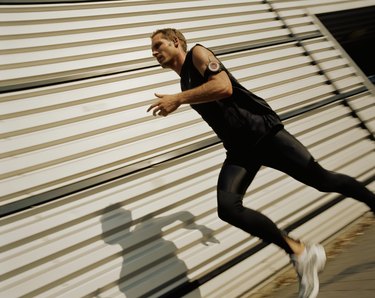
When you exercise, your respiratory rate increases. This is true regardless of whether you exercise by stationary methods such as weight lifting, or by a traveling method such as jogging or biking. Clearly, an active body needs more oxygen than a body at rest. The reason for this lies in the complex chemical processes in your muscles and your bloodstream.
Increased Energy Requirements
Video of the Day
Your body needs oxygen at all times. Oxygen and glucose are your body's basic energy building blocks. It requires them to make your heart pump blood, to keep your lungs inhaling and exhaling, and to allow every other organ and cell to function. Every one of these activities uses up energy that must be replaced in part by taking in more oxygen.
Video of the Day
When you exercise, your muscles move more vigorously than when you are at rest. Their metabolic rate increases. They need more energy, so they produce more of the chemical energy molecule ATP. You need oxygen to produce ATP, so the more ATP you produce, the more oxygen your body requires.
Decreased Blood Oxygen Reserves
Oxygen reaches your muscles and other parts of the body by means of your bloodstream. Oxygen dissolves into the plasma, where most of it -- about 98.5 percent, according to information from Eastern Kentucky University -- becomes attached to hemoglobin molecules. While you're resting, only about 20 to 25 percent of the hemoglobin molecules give up their oxygen to your tissues. A lot of oxygen remains in the bloodstream in reserve.
As you begin to exercise, you use up these reserves, and oxygen-hemoglobin saturation in your bloodstream drops sharply. You need to take in more oxygen to make up for this loss and fulfill your body's increased need for oxygen.
Decreased Partial Pressure
Partial pressure of oxygen, or PO2, refers to the individual pressure exerted by oxygen in a mixture of gasses or substances. As oxygen leaves your bloodstream and enters your tissues, your bloodstream PO2 drops. At lower PO2 levels, your red blood cells make more of a substance called 2,3-diphosphoglycerate. The increased presence of this substance helps alter the structure of your hemoglobin such that it gives up its oxygen more readily.
The Bohr Effect
Hemoglobin's faster release of oxygen, otherwise described as a lowered oxygen-hemoglobin saturation level, is encouraged by other conditions in an exercising body. As your muscles make extra ATP, the basic unit of energy, they also produce waste products. These are primarily carbon dioxide, or CO2, and hydrogen ions, or H+. Christian Bohr discovered in 1904 that increased concentrations of these substances encourage hemoglobin to release oxygen molecules. This principal, the Bohr effect, makes it easy for exercising muscles and other active tissues to extract the oxygen from the bloodstream in increased amounts -- but it also means you need to replenish your oxygen supplies that much more quickly.
- The University of New Mexico; Making Sense of Calorie-burning Claims; Robert A. Robergs, Ph.D. and Len Kravitz, Ph.D.
- Eastern Kentucky University Department of Biological Sciences: Respiration
- Washington University in St. Louis; Metal Complexes in the Blood for Oxygen Transport; Rachel Casiday and Regina Frey; Sept. 5, 2008
Is this an emergency? If you are experiencing serious medical symptoms, please see the National Library of Medicine’s list of signs you need emergency medical attention or call 911.